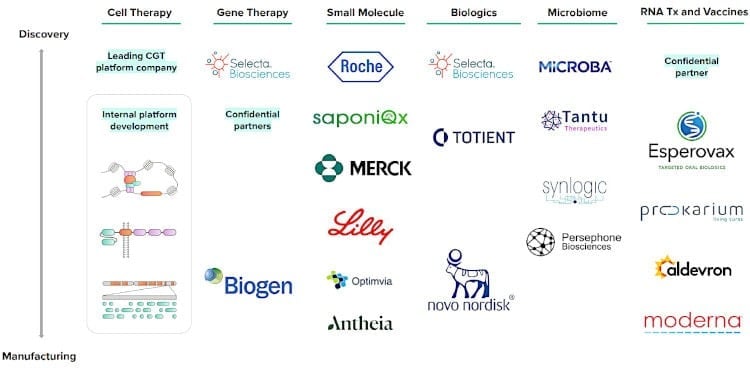Ginkgo Bioworks Stock: Finally Time to Go Long?
Table of contents

Regular Nanalyze readers often hear this refrain from us: We invest in companies, not stories or stocks. That means we don’t allow ourselves to get caught up in the hype or volatility that accompanies retail investing. And that’s why we’ve worked hard to build objective metrics and processes for investing in disruptive technologies, because we get just as excited about this stuff as everyone else who reads our analyses. Synthetic biology is one of those emerging tech themes that we believe can truly be transformative – but extremely risky. The company that has come to embody all of our hopes and disappointments is synbio darling Ginkgo Bioworks (DNA).
Short History of Ginkgo Bioworks Stock Coverage
We first started writing about Ginkgo Bioworks back in March 2016 in an article about three nanorobot factories. Since then, we’ve written at least another half-dozen articles about the Boston-based company, which has basically turned lab R&D for designing and programming cells into a high-throughput factory using machine learning, robotics, and related technologies. From its heady days as a rare biotech unicorn and leader in industrial synbio to its disappointing decision to go public via merging with a blank check company and subsequent controversies related to a short-seller report, Ginkgo Bioworks has attracted our attention like few others.
The company recently announced its year-end 2022 results in a nearly 90-minute presentation. On one hand, it was probably one of the most explicitly detailed investor presentations we’ve watched. Co-founder and CEO Jason Kelly is charismatic and can talk about cell engineering in a language that even an MBA can understand. On the other hand, while Kelly’s charm can be disarming, there was an underlying current of desperation and defensiveness to the presentation.

Our last article on Ginkgo Bioworks stock was just about a year ago, after the company had released its final 2021 financial results, temporarily giving the stock a jolt. We found some positive takeaways – diversifying revenue streams chief among them – but held back from adding it to the Nanalyze Disruptive Tech Portfolio because the stock was still too richly valued, among other things. That’s no longer the case: The company’s simple valuation ratio (market cap of $2.8 billion/annualized revenues of $392 million) is 7. We consider anything higher than 20 as too expensive, so valuation is no longer an obstacle. However, all revenues are not created equal. We’re purely interested in “pure Foundry” revenues, a label that’s now changed to “cell engineering.” Related party revenues and anything related to the Rona isn’t what we’re here for.
The Bull Case for Ginkgo Bioworks Stock
We know a lot of our readers have been very interested in Ginkgo Bioworks stock since it completed a reverse merger with a special purpose acquisition company (SPAC) in September 2021. In the remainder of this article, we’re going to look at the emerging bullish positives for Ginkgo Bioworks stock, based on its year-end performance and strategic outlook. We’ll then follow up with a second article in the near future that revisits all the concerns we’ve voiced in the past.
Cell Engineering Revenue on the Right Track
One of our long-standing complaints about Ginkgo Bioworks is that the company’s revenues have been overly reliant on related-party revenues – work performed for subsidiaries, spin-outs, and joint ventures. This is revenue from its core business of cell engineering (what Ginkgo used to refer to as its Foundry). Over the last couple of years, the company has made steady progress in moving away from this incest money to working with actual clients outside the Ginkgo family:

Moving forward, Ginkgo is also decoupling its service revenue from what it calls downstream revenues within its cell-engineering business. The former represents contracted, predictable revenue directly linked to its cell foundries. The latter reflects royalties, milestones, and even equity connected to the very unpredictable success of its customers. This would include something like a royalty payment on a drug developed by a pharmaceutical company – a payoff that can take years to materialize, if ever. Nearly all of Ginkgo’s 2022 downstream revenue came from just one customer – Cronos Group, a cannabis company developing novel cannabinoids. (Does anyone else find this to be odd?)
In fact, this revenue stream is so unpredictable that Ginkgo is not even offering guidance for 2023.

Based on this chart, the company is expecting a sizable jump in services revenue for cell programming, from $106 million in 2022 to at least $175 million in 2023. That’s the exact revenue target that Ginkgo forecasted in its shiny SPAC investor deck – but for last year. Remember, we’re being bullish here, so let’s move on.
Biosecurity Beyond the Covid Bump
One of the more interesting revelations during what was mostly a one-man show from CEO Kelly involved the company’s nascent biosecurity business. Kelly insisted during the call that biosecurity had always been on the company’s radar, and the Rona offered a way to jumpstart that business segment, dubbed Concentric by Ginkgo Bioworks. Whatever. We’re finally seeing the covid bump smooth out in 2023, with biosecurity revenues expected to drop by as much as 70%, as covid testing peters out.

The positive spin: About half of the $100 million or so from Concentric for this year will come from recurring, subscription-based revenue. The company is leveraging its covid infrastructure to pivot into what Kelly called a global “bio-radar” that will detect all sorts of biological threats, such as monitoring wastewater for new viruses or variants at airports. How does this relate to a factory of the future harnessing the powers of nature to transform the trillion-dollar manufacturing industry? You’ll need to use your imagination because it’s not entirely clear from where we’re sitting.
Diversification of Industries
Another evolution that apparently has been in the works from the beginning is the company’s shift into markets outside of industrial synbio – specifically, agriculture and pharmaceuticals. Ginkgo Bioworks added 59 new programs last year, representing 90% growth over 2021, and many of those were in ag/food and pharma. That number is pretty darn close to what the company had actually promised (60 new programs) in its 2021 SPAC days.

Kelly implied that biopharma could be a big part of the company’s future, rather than industrial cell engineering, which appears to have plateaued for now (and Ginkgo awaiting the flow of downstream revenue). However, most of the payoff is expected to be in those unpredictable downstream revenues rather than upfront fees. When pressed specifically on that point, Kelly basically said it was harder to close sales with fees front-loaded into a deal. Maybe that reflects the fact that the company is a relatively unknown entity among the pharma crowd? That may soon change, as Ginkgo has assembled quite a list of biopharma partners:

This is obviously an area of the business we want to watch, especially with competition in the drug discovery business becoming extremely competitive with companies employing machine learning and computational chemistry at scale. Even more granularity into the revenues from these biopharma cell programs would be helpful to investors in the future.
The Price is Finally Right
As we mentioned earlier, Ginkgo Bioworks stock is finally trading at a simple valuation ratio (market cap/annualized revenue) where we could consider an investment. In the span of about 18 months, the company has lost about 80% of its original valuation at the time of the SPAC merger. Don’t forget baked into the price are 10 other companies that Ginkgo has acquired, including a half-dozen in 2022 alone. The biggest name of the bunch, Zymergen, had IPO’d in April 2021 with a market cap of $3 billion. Ginkgo picked up the company for just 10% of that price through an all-stock transition, with the intent of absorbing and integrating Zymergen’s automation and software capabilities. You’re getting Zymergen + Gingko which collectively commanded an $18 billion valuation at IPO now at a valuation of just $2.85 billion.
The price is right, but is Ginkgo Bioworks stock the right synbio stock to own at any price?
A Boulevard of Broken Dreams
Investors are wise to exercise extreme caution when looking for a silver needle in the haystack of synthetic biology stocks. Ever since the days of Intrexon (we were investors), there have been a myriad of failures and broken promises. The similarities between Intrexon’s EEC business model and Ginkgo’s “pay us in equity” model can’t be ignored. Then you have Zymergen which came out of the gates and imploded just months later. Were those ashes really worth gathering up? Ginkgo thought so. Then there’s Amyris and all their related party revenues and continuing struggles. Further failures in the synbio space can be found in our piece on WTF is Going on with Synbio Stocks.
Admittedly, we were so excited by the Ginkgo Bioworks story that we dipped our toes in the water for their SPAC debut, only quickly pulling them out after realizing we were breaking our own rules. That decision means we avoided the 86% drop in share price that followed. Before climbing back on board, we want to vet this firm six ways to Sunday so that we can enter our position with conviction and assurance. As risk-averse investors, the situation demands such rigor.
Conclusion
There are still a lot of outstanding issues, starting with $1.9 billion in stock-based compensation that accounted for most of the $2.2 billion in 2022 losses. Other questions we’ll consider: How much should investors be worried about the lack of downstream revenues from industrial customers? How viable is the nascent biopharma business? Even with $1.3 billion in cash and assets, how much runway does Ginkgo Bioworks have? The dust is just now settling on all those 2022 acquisitions, so can we expect a big write-off on goodwill impairment?
Readers keen on Ginkgo Bioworks will definitely want to keep an eye out for our next piece where we evaluate the risk-reward on offer from the leading story in synthetic biology today.
Sign up to our newsletter to get more of our great research delivered straight to your inbox!
Nanalyze Weekly includes useful insights written by our team of underpaid MBAs, research on new disruptive technology stocks flying under the radar, and summaries of our recent research. Always 100% free.
















The connection between “bio-radar” and the foundry is Next generation DNA sequencing. This is how ginkgo assays it’s microbes as well as how it surveils circulating microbes.
Next generation sequencing is why we invested in Illumina. We’re interested in cell engineering which is the entire promise of synthetic biology. If Gingko starts to pivot away from that promise, it’s a huge red flag.
Oh, also countries are eventually going to require monitoring of gmos as they become ubiquitous while the common folk never ever sit comfortably with that. So ginkgo already having a monitoring platform will likely be an asset as they attempt to deploy gmos in uncontrolled novel environments. Honestly I can’t imagine the USDA ever allowing gmo seed coating without such a requirement.
We’ve been waiting for people to “get over
GMOs ARE ubiquitous. Currently, over 90 percent of U.S. corn, upland cotton, and soybeans are produced using genetically engineered varieties. (Source: USDA) Again, this isn’t why we found Gingko appealing. We’re solely interested in their ability to engineer cells and displace manufacturing methods across numerous industries. You know, harnessing the power of nature, wielding the greatest technology know to man, the promises that synthetic biology advocates have been peddling for over a decade now.
Sorry, I should have specified microbial gmos. Macroscopic gmos are more culturally accepted because people trust things they can see, yet they still barely trust even them. People already distrust ALL bacteria, let alone gmo bacteria.
I know the people are wrong, but this is just the case. I don’t see the USDA allowing microbial gmos to be sown into open fields without some requirement to monitor “escape.”
Anyway, you’re point is well taken that this should not be THE business of gingko.
Interesting, thank you for making that distinction as we hadn’t considered that. Ginkgo’s work on anything related to the FDA will be far more regulated than – say – the industrial chemicals realm which should be the low hanging fruit here. They should be absolutely killing it right now by designing all kinds of miracle enzymes for industrial production processes.
Basically all of industrial microbiology for commodity and specialty chemicals went bankrupt after the price of oil collapsed in 2015. It really didn’t matter how miraculous your enzymes were if sugar was $0.40/lb and oil was $35 a barrel. Though I am relived to hear that Genomatica (which Ginkgo owns I think?) will be building a second butanediol plant so perhaps the recent run up in oil has changed things. However it is fairly concerning that they have not absolutely decimated chemicals markets such as, say, amino acids, which have no viable petrochemical route.
Great comment here, thank you for taking the time to add value to the conversation. Indeed it’s concerning that the only big milestone win so far has been in cannabinoids. Zymergen failed at developing whatever film they were working on, then they pivoted to biopharma and Gingko bought them. Why Gingko would do that when they have a cell engineering platform that harnesses the very power of nature is confusing. Below from the Gingko website is what we’re all excited about.
Ginkgo Bioworks uses the most advanced technology on the planet—biology—to grow better products. We program cells to make everything from food to materials to therapeutics.
So when a company that calls itself, “The Organism Company” decides to get into COVID testing, or acquire a struggling competitor, it’s a big concern. How about we stick with the original plan of changing the world by engineering cells to do mankind’s bidding?
I suspect SBC will be much more limited going forward, that makes me bullish all things considering.
Cheers Matt. Agree that it might tail off going forward. We have another piece coming out soon to coincide with their 10-K that will revisit a lot of the old concerns we had to see what’s still sticking around.
Is there a concern with the amount of shares outstanding?
Good question. They could reverse split by 100 and problem solved 😉 The problem is the increase of shares outstanding which leads to dilution. We’ll cover this in a follow-up piece.
Also, what’s with all the insider selling going on in Ginko?
We had to remove the link as we don’t allow them. That said, it also didn’t provide context. When someone holds 20 million shares, and sells a million, that’s not very significant in the context of their total exposure. All insider trading needs to be put into context for the information to be useful. But your point is noted, thank you!
Which SEC form did Ginkgo outline their insider selling schedule per Rule 10b-5? I looked and found their almost daily published Form 4s but I can’t find the overarching schedule. Jason & Co. selling sounds like it’s inviting shorts to come in. Same thing happened to $TSLA not too long ago with Elon’s $TWTR acquisition.
Trying to attribute movements in share price to insider selling and shorting behavior is speculating which isn’t useful to be honest. If insiders are selling a large number of shares RELATIVE to their entire holdings, then it’s somewhat useful information to know, however, founders taking money off the table is behavior that’s hard to excuse. The fact that they know what is being telegraphed to the market, and choose to do it anyway without some sort of BOD oversight, could be a concern. As for Gingko, we need to put this insider selling in context. Does it look like what happened over at Xometry, or is it just some small relative selling? Perhaps we’ll look at that briefly in our next Gingko piece. 🙂
I may consider it once the idiot insiders stop selling their insider stock on almost a daily basis.
Frequency isn’t something we had thought about. Does it really matter if an insider sells 10,000 shares in a day, or 1,000 on each of 10 days? What matters in our minds is the total number of shares sold relative to their total holdings. Perhaps they’re selling in smaller blocks to avoid pushing down the share price (basic supply and demand stuff). Again, this is al relative and needs to be put into context.
The thing I find worrying about Ginkgo are huge losses they generate. In 2022 they have net loss $2.18B while renenue was $478M and the current market cap is $2.3B. So their one year net loss is close to their market cap ! In 2021 net loss was $1.8B. We also have to remember years 2021 and 2022 were very fortunate for Ginkgo as they benefited from COVID-19 testing (that COVID-19 testing revenue will be gone now). So I don’t understand why they generated such huge losses in 2021 and 2022. Can we expect similar loss in 2023 ?
The other thing that doesn’t buid my confidence is a lot od share selling activity by the directors. They have been selling on regular basis every month. At the same time Kelly says the stocks is undervalued. So why he keeps selling undervalued stock (btw: the stock is down 88%) ? Kelly and others were selling millions of shares recently ..
I guess Ginkgo was more about hype than reality. Remember the saying: “fake it before you make it”.
Based on that hype they managed to get huge valuation when going public. When trading started the share price moved from $10 to $13 in the next 2 months and then the collape began as the stock market started having correction, but the collape of DNA shares was much larger than the market. Now the share price is $1.24. That’s 88% down from the initial price.
Why they bought Zymergen ? Zymergen was strong with automation, so I think buying Zymergen significantly increased automation expertise for Ginkgo and will improve its platform. Automation is a critical thing for Ginkgo and that became clear to me when I listened to their latest Q4 earning call. So overall I believe buying Zymergen was a good idea and they bought it for only 5.25% of the combined companies value (at the time of the deal it was valued at $300M, but as the DNA shares fell not it is only $140M).
So in general I think they successfuly managed to ‘fake it’, now is the hard work to ‘make it’. That requires a lot of investment and time and hard work. They are well funded so there is a good chance they can make that transition successfully, but nothing is guaranteed. They are going to focus on increasing platform efficiency. That is the critical factor, as now they burn a lot more than they generate in revenue.
Jason Kelly (co founder and CEO) owns about 12,594,680 units of Ginkgo Bioworks Holdings, Inc common stock. In the last 2 years at Ginkgo Bioworks Holdings, Inc, Jason Kelly has sold an estimated value of $29.67M worth.
So it is a big red flag. His current holding is worth $15.6M and he sold already $29.67M and he keeps selling it every month ..